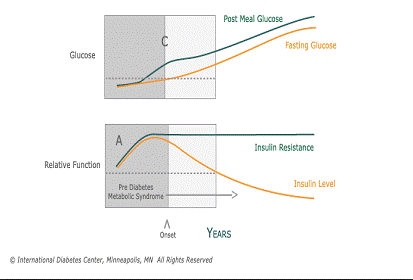The Development of Type 2 Diabetes
Because the majority of diabetic patients have type 2 diabetes, the rest of this web module will focus on diagnosis and management of this population.
In type 2 diabetes, it is important to remember that insulin resistance and beta cell dysfunction are closely linked. Before type 2 diabetes fully develops (“prediabetes” period), insulin resistance may already be present. During this time, insulin secretion is usually increased, but fasting and post-prandial glucose blood levels may still be normal.At some point, type 2 diabetics can no longer increase or maintain insulin secretion levels to compensate for increasing insulin resistance. Initially, mild to moderate glucose intolerance will develop. Over several years, insulin secretion can no longer meet insulin needs and eventually fasting hyperglycemia develops. Once fasting glucose exceeds 126 mg/dL, diabetes is present (point C on the graph).
The natural history of the disease suggests prevention and early treatment are paramount. It also suggests that combination therapy for type 2 diabetes will likely play a role in most patients in order to address the insulin resistance and deficiency.
Screening for Diabetes and Prediabetes
Almost one third of adults with diabetes in the United States are undiagnosed. Half of undiagnosed patients are eventually diagnosed after complications of diabetes develop–especially cardiovascular complications. Screening for diabetes allows for both diagnosis and intervention at earlier stages and may even prevent diabetes from developing. Criteria for testing for prediabetes or diabetes in asymptomatic adult individuals as per the American Diabetes Association:
- Testing for prediabetes or diabetes should be considered in all individuals aged 45 years and above, or at any age in those with a BMI ≥25 and have >1 additional risk factor (see below)
- if tests are normal, should be repeated at 3-year intervals. This frequency of rescreening is not based on expert opinion.
- The A1C, fasting glucose or 75-g OGTT (glucose challenge) are acceptable.
- Testing should be considered at a younger age or be carried out more frequently in individuals who are overweight (BMI ≥25) and have one or more additional risk factors, as follows:
- Overweight (BMI >85th percentile for age and sex, weight for height >85th percentile, or weight >120% of ideal for height)
- Family history of type 2 diabetes in first or second-degree relative
- Race/ethnicity (Native American, African American, Latino, Asian American, Pacific Islander)
- Signs of insulin resistance or conditions associated with insulin resistance (acanthosis nigricans, hypertension, dyslipidemia, or PCOS)
- Maternal history of diabetes or GDM
A patient can be diagnosed with diabetes mellitus using an elevated Hemoglobin A1C level. (Choose the one best answer.)
Diabetes Screening Tests
Multiple screening tests are available for diabetes.
| Screening Tests for Pre-Diabetes and Diabetes | Notes about use of each test |
|---|---|
| A1C | Anytime-nonfasting Can be affected by hemogobinopathy or rbc turnover |
| Fasting plasma glucose (FPG) | Fasting 8 hr Nonpregnant Cheap Most commonly used |
| Random plasma glucose | Polyuria, polydipsia, weight loss |
| 75-gram oral glucose tolerance test (OGTT) | Expensive Inconvenient for patients; rarely used in clinical practice More sensitive, slightly more specific than FPG. Poorly reproducible |
Diagnostic Categories
The diagnoses of prediabetes and diabetes are included in the table below. Note that “prediabetes” includes diagnostic sub-categories of impaired fasting glucose and glucose intolerance. These states are not outright clinical entities in themselves, but are risk factors for developing diabetes and cardiovascular disease.
| Normoglycemia | Pre-diabetes | Diabetes* |
|---|---|---|
| A1C <5.7 | A1C 5.7 – 6.4% | A1C ≥6.5% |
| FPG <100 mg/dL | FPG 100-125 mg/dL = IFG | FPG ≥126 mg/dL |
| 2 hr OGTT < 140 mg/dL | 2 hr OGTT 140-199 mg/dL = IGT | 2 hr OGTT ≥ 200 mg/dL |
| Symptoms of diabetes and casual plasma glucose concentration ≥ 200 mg/dL | ||
| * Diagnosis of diabetes with A1C, FPG or OGTT must be confirmed on another day. | ||
Testing for type 2 diabetes in Children as per the American Diabetes Association
The incidence of type 2 diabetes in children and adolescents has dramatically increased in the past 10 years.Only children at increased risk for the presence of the development of type 2 diabetes should be tested. Criteria: Overweight (BMI >85th percentile for age and sex, weight for height >85th percentile, or weight >120% of ideal for height), plus any two of the following risk factors:
- Family history of type 2 diabetes in first or second-degree relative
- Race-ethnicity (Native American, African American, Latino, Asian American, Pacific Islander)
- Signs of insulin resistance or conditions associated with insulin resistance (acanthosis nigricans, hypertension, dyslipidemia, or polycystic ovarian syndrome)
- Maternal history of diabetes or GDM
Age of initiation: age 10 years or at onset of puberty, if puberty occurs at a younger age Frequency: every two years Test: FPG preferred
Testing for type 2 diabetes in postpartum women with gestational diabetes as per the American Diabetes Association
When should women with gestational diabetes (GDM) and no pre-pregnancy history of diabetes be screened initially for diabetes mellitus? (Choose the one best answer.)
| << Facts About Diabetes |
